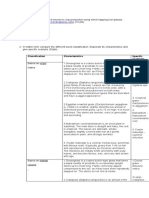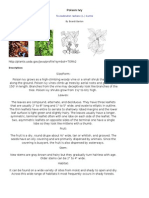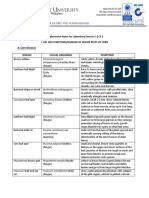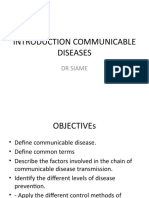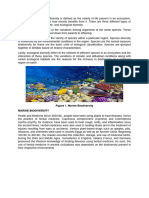0 ratings0% found this document useful (0 votes)
84 viewsRice Whorl Maggot (Hydrellia (Diptera: Ephydridae: Philippina Ferino)
Rice Whorl Maggot (Hydrellia (Diptera: Ephydridae: Philippina Ferino)
Uploaded by
Pamela GabrielRice whorl maggot is a small gray fly that damages young rice plants during the tillering stage by feeding within leaf whorls, discoloring and damaging leaves. Damage ranges from slight narrowing to complete destruction of leaves.
Copyright:
© All Rights Reserved
Available Formats
Download as PPT, PDF, TXT or read online from Scribd
Rice Whorl Maggot (Hydrellia (Diptera: Ephydridae: Philippina Ferino)
Rice Whorl Maggot (Hydrellia (Diptera: Ephydridae: Philippina Ferino)
Uploaded by
Pamela Gabriel0 ratings0% found this document useful (0 votes)
84 views22 pagesRice whorl maggot is a small gray fly that damages young rice plants during the tillering stage by feeding within leaf whorls, discoloring and damaging leaves. Damage ranges from slight narrowing to complete destruction of leaves.
Original Title
rice pest
Copyright
© © All Rights Reserved
Available Formats
PPT, PDF, TXT or read online from Scribd
Share this document
Did you find this document useful?
Is this content inappropriate?
Rice whorl maggot is a small gray fly that damages young rice plants during the tillering stage by feeding within leaf whorls, discoloring and damaging leaves. Damage ranges from slight narrowing to complete destruction of leaves.
Copyright:
© All Rights Reserved
Available Formats
Download as PPT, PDF, TXT or read online from Scribd
Download as ppt, pdf, or txt
0 ratings0% found this document useful (0 votes)
84 views22 pagesRice Whorl Maggot (Hydrellia (Diptera: Ephydridae: Philippina Ferino)
Rice Whorl Maggot (Hydrellia (Diptera: Ephydridae: Philippina Ferino)
Uploaded by
Pamela GabrielRice whorl maggot is a small gray fly that damages young rice plants during the tillering stage by feeding within leaf whorls, discoloring and damaging leaves. Damage ranges from slight narrowing to complete destruction of leaves.
Copyright:
© All Rights Reserved
Available Formats
Download as PPT, PDF, TXT or read online from Scribd
Download as ppt, pdf, or txt
You are on page 1of 22
Whorl maggot is a small gray fly
with strong preference to young
transplanted rice plants.
The whorl maggot causes
damage during the tillering
stage of rice, for about 40 days
after transplanting, but
thereafter little damage occurs.
Rice whorl Damage symptoms are visible
maggot (Hydrellia when the leaf grows out of the
philippina Ferino) whorl. The edge of the leaf is
discolored, whitish or yellowish.
[Diptera: The extent of damage varies
Ephydridae from slight feeding causing a
“pinched” or narrow area or
pinholes to a severely damaged
leaf which is completely broken
due to extreme feeding across
the entire width of the leaf.
•Moth is immaculate white with light
brown and black spots on the wings.
•Eggs are pale, yellowish green, laid
in one or two long rows on under
surfaces of leaves drooping into the
water.
Rice •Larvae are yellowish green,
translucent with threadlike gills on
caseworm body.
•The freshly hatched larvae feed on
(Nymphula the surface of the tender leaves but
later instar larvae, with their heads
depunctalis and thoraces protruding from within
the case, feed on the surface of the
(Guenee)) older leaves.
•The larva consumes the green leaf
[Lepidoptera: tissue, leaving only the papery upper
epidermis. Frequently several larva
Pyralidae] attack a plant and cut off most of the
leaf tips for making cases and may
consume the remaining leaves.
Uneaten leaves can be seen floating
on the paddy water surface.
Moth is triangular, cream
colored, and land on leaf
Rice green surface with its head
hairy caterpillar pointing downward
(Rivula atimeta
Larvae are green with pair
of white line running along
(Swinhoe))
dorsal side of the hairy
[Lepidoptera:
body
Noctuidae]
Young larvae scrape tissue
from leaf blades leaving
only the lower white
surface. Older larvae cut
out section of leaf blades
Adult is yellow orange with
two diagonal, dark red bands
Rice green on each front wings
semilooper Larvae are similar in size to
(Naranga that of rice green hairy
aenescens caterpillar except for the
(Moore)) looping movement and
[Lepidoptera: absence of long body hairs
Noctuidae] The damage is identical to
that of the green hairy
caterpillar
The orange red fly is mosquito-like
with long, slender legs and bead-like
antennae . This insect is nocturnal and
is attracted to light.
Eggs are shiny white with pinkish, red
or yellow shading and are laid openly
Asian rice gall on leaf blades.
midge Soon after hatching, the larva moves
down between the leaf sheath and the
stem until it reaches the growing point
Orseolia oryzae of the apical or side buds and feeds at
the base of the growing plant. A gall
(Wood-Mason) begins to form and eventually results
in the development of a tubular gall or
Diptera: “onion leaf”
Plant damage is caused by the
Cecidomyiidae
transformation of tillers into tubular
galls which do not bear panicles.Early
infestation also causes excessive
tillering but these new tillers often
become infested and few bear
panicles.
Adult beetle is small, metallic blue-
black and covered with short and
long spines in the thorax and
forewings.
Rice hispa Both adults and larvae feed on the
(Dicladispa armigera leaf tissue between the epidermal
membranes. The adults scrape the
(Olivier)) upper surface, leaving only the
[Coleoptera: lower epidermis. Adult feeding
damage shows white streaks along
Chrysomelidae] the long axis of the leaf.
Larvae produce irregular
longitudinal white mines as they
tunnel between the epidermal
layers.
Affected leaves may wither and
die, giving the field a burnt
appearance
The moths of the 3 species: C.
medinalis , M. patnalis and M.
exigua are yellow brown which
can be differentiated with dark line
Rice leaffolders markings on their wings.
(Cnaphalocrocis Damage to the rice plant is caused
medinalis (Guenee), by the caterpillars which fold the
leaf blades into tubular structures
Marasmia exigua and feed on the green leaf tissues.
(Butler), The affected leaves dry up giving
Marasmia patnalis seriously infected fields a scorched
appearance .
Bradley) The discoloration and folding of
[Lepidoptera: the leaves affects the general vigor
Pyralidae] of the rice plants and reduces their
photosynthetic ability. The
damaged leaves also serve as an
avenue for fungal and bacterial
infection.
Rice thrips are minute, soft-
bodied, elongated insects
having narrow wings with long
marginal hair and asymmetrical
rasping and piercing
Rice thrips mouthparts.
(Stenchaetothrips Adults and nymph prefer to
biformis (Bagnall)) feed on young plants and
seedlings. Damaged leaves
[Thysanoptera: show fine white to silvery
Thripidae] scraped areas. Due to severe
rasping, the leaves roll and may
even wither.
Leaf damage increases in dry
weather, particularly when
there is drought stress. Upland
rice being prone to drought
commonly suffer from thrips
infestation.
The drab, dark brown butterfly
has round spots on the wings.
Rice green- The large, light green larva
horned blends into rice foliage but is
easily recognized by the two
caterpillar
prominent horns projecting
(Melanitis leda from the flat quadrangular head
ismene Cramer, and from the tip of its abdomen.
Mycalesis sp.) The green-horned caterpillar
[Lepidoptera: damages rice during the larval
Satyridae] stage through defoliation. Each
larva is capable of defoliating a
great quantity of leaf tissue
during its 3-week larval period.
Moths of rice skippers skippers,
namely, P. mathias (Fabricius) and P.
guttata Bremer and Grey are brown in
color with transparent white marks on
Rice skippers the forewings and their antennae have
hook-like tips. The hind wings of P.
(Pelopidas mathias mathias have no transparent spots but
P. guttata bear four white transparent
(Fabricius), spots.
Parnara guttata
The head of P. mathias larva has red
oblique bands on each side while P.
Bremer and guttata larva has a brownish frontal
W-band on its head
Grey) The larvae of two species of rice
[Lepidoptera: skippers have similar feeding habits.
They skeletonize the leaf by eating the
Hesperiidae] entire leaf margins and leave the
midrib uneaten.
Several genera and species of
short-horned grasshoppers of
varying shapes are attacking the
Rice short-horned rice plants. The common genera
are easily identified. Oxya and
grasshoppers Acrida species have no deep
Oxya sp. and furrow along midline of head
but present in Atractomorpha.
Acrida sp. Oxya have large rounded eyes
[Orthoptera: with bold heads while Acrida
Acrididae], and Atractomorpha have small
elongate eyes and strongly
Atractomorpha sp. slanted faces.
[Orthoptera: Both nymphs and adults feed
on leaf tissue consuming large
Pyrgomorphidae] sections from the edges of the
leaf blades.
Green leafhoppers are the most common
leafhoppers in the rice plant.
Four species transmit virus and
mycoplasma-like diseases of rice such as
tungro, yellow dwarf, waika, transitory
Green yellowing, gall dwarf, and dwarf.
Leafhoppers can be distinguished by the
leafhoppers
shape of the head and the presence or
absence of black lines or bands between
(Nephotettix the eyes. For instance, the temperate
species, N. cincticeps (Uhler) has bluntly
spp.) rounded head and without central black
spots on the forewings. The tropical
[Hemiptera: Asian species N. nigropictus (Stal) has a
transverse black band on the head and
Cicadellidae] central black spots on the forewings. On
the other hand, N. virescens (Distant) has
a pointed head without black bands.
Both nymphs and adults feed by
extracting plant sap with their needle-
shaped mouthparts.
The zigzag leafhopper can be
readily recognized by the
Zigzag leafhopper brownish zigzag pattern on
(Recilia dorsalis its wings.
(Motschulsky)) It feeds well on rice and some
[Hemiptera:
Cicadellidae] grassy weeds, and is an
important vector of viral
diseases.
The adult brown planthopper is
light to dark brown. The male is
distinctly smaller than the female.
The adult planthoppers occur in
Brown planthopper both the short- and long- winged
(Nilaparvata lugens forms.
(Stal)) [Hemiptera: The eggs, characterized by broad
flat egg caps, are laid in batches in
Delphacidae] the leaf sheath or midrib of the
leaves. There are five nymphal
instars. Newly emerged nymphs
are white, but later turn brown.
Removal of plant sap and blockage
of vascular bundles by feeding
sheaths cause the plant to wilt and
die. This condition is referred to as
hopperburn.
Brown planthopper transmits
grassy stunt and ragged stunt.
The adult white-backed
planthopper has a prominent
White-backed white band on its thorax
planthopper
Male occurs only in long-
winged form while female
(Sogatella furcifera can either be short or long-
(Horvath) winged.
[Hemiptera: Eggs are laid in rice stem or
Delphacidae] leaf sheaths.
Newly emerged nymphs are
white but show coloration as
they mature.
Feeds equally on some
grasses as well as on rice.
Adults are grayish brown to
charcoal black with a broad and
hard abdominal covering.
Malaysian black Females lays grayish-pink eggs
bug (Scotinophara in clusters, and sit over the eggs
coarctata to protect from parasites and
predators.
(Fabricius)) Nymphs and adults remove
[Hemiptera: plant sap and cause plants to
Pentatomidae] wilt, producing condition
referred to as “bug burn”.
Black bug feeding also causes
deadhearts and whiteheads
similar to stemborer damage.
Adults are brown and slender
with long legs and antennae.
The dark reddish brown, disc-
shaped eggs are laid in rows on
Slender rice bugs or rice foliage.
rice bugs (Leptocorisa Nymphs are green with white
oratorius (Fabricius) bands on its reddish antennae
and L. acuta and their bodies elongate as
(Thunberg)) they mature.
[Hemiptera: Mature nymphs feed at higher
Alydidae) rate than the adults.
Rice bug feeding at milking
stage results to empty grain
while feeding at dough stage
gives rise to broken/chaffy
grains.
Stem borers belong to the Order Lepidoptera. Adults are
harmless but the larvae bore into the plant stem and do the
damage while feeding inside the stem. Moths are nocturnal,
attracted to light and are strong fliers.
Yellow stemborer(Scirpophaga incertulas
(Walker)) [Lepidoptera: Pyralidae]
White stemborer (Scirpophaga innotata
(Walker)) [Lepidoptera: Pyralidae]
Pink stemborer (Sesamia inferens (Walker))
[Lepidoptera: Noctuidae]
Striped stemborer (Chilo suppressalis
(Walker)) [Lepidoptera: Pyralidae]
Gold-fringed stemborer (Chilo auricilius
Dudgeon) [Lepidoptera: Pyralidae]
Dark-headed stemborer (Chilo polychrysus
(Meyrick)) [Lepidoptera: Pyralidae]
Adults and nymphs have
enlarged and spade-like front
legs
Oriental mole Tunnel in the soil with its
cricket enlarged front legs.
(Gryllotalpa Adults and nymphs feed on
sown seeds and roots.
orientalis
Young plants can die from
Burmeister)
root loss producing bare
[Orthoptera: spots and missing plant stand
Gryllotalpidae] in the field
Adults are gray brown with
stout and smooth bodies
White grubs Larvae are white with large
yellow brown heads. They
[Leucopholis feed on the root mass
irrorata trimming the roots.
(Chevrolat) Young larvae roll into C
shape when disturbed while
[Coleoptera: older larvae have an enlarged
Scarabaeidae] area at the tip of the
abdomen.
Leaves of damage plants turn
orange-yellow, wither and
die due to root loss.
You might also like
- Biochemistry CasesTeenage Weakling 2015Document5 pagesBiochemistry CasesTeenage Weakling 2015Neel KotrappaNo ratings yet
- Sample of A Project Proposal Provision of Farm Inputs Production of Palay Corn Mongo Peanut and CamoteDocument12 pagesSample of A Project Proposal Provision of Farm Inputs Production of Palay Corn Mongo Peanut and CamotePamela Gabriel100% (1)
- Survival MDDocument206 pagesSurvival MDEddie Kluss III100% (15)
- Inquisitor Character Creation and AdvancementDocument10 pagesInquisitor Character Creation and AdvancementMichael MonchampNo ratings yet
- Edible Mushrooms As A Novel Trend in The Development of Healthier Meat Products PDFDocument7 pagesEdible Mushrooms As A Novel Trend in The Development of Healthier Meat Products PDFRyan HaryoNo ratings yet
- Identification of Insect Pests of Maize, Wheat and Ragi and Their Damage SymptomsDocument75 pagesIdentification of Insect Pests of Maize, Wheat and Ragi and Their Damage Symptomsanbu sezhianNo ratings yet
- Insect Pests of Amaranthus and Their ManagementDocument4 pagesInsect Pests of Amaranthus and Their ManagementIJEAB JournalNo ratings yet
- Pests of CitrusDocument29 pagesPests of CitrusPalash MondalNo ratings yet
- 33 Mangroves - Eleonora Yuanita IntanDocument34 pages33 Mangroves - Eleonora Yuanita IntanEleonora IntanNo ratings yet
- Agrotis IpsilonDocument17 pagesAgrotis IpsilonMayuri VohraNo ratings yet
- Pest of PulsesDocument53 pagesPest of PulsesD.P. DeepakNo ratings yet
- EntomologyDocument56 pagesEntomologyGwyneth Dane DangcatanNo ratings yet
- Grassland Ecosystem: Mark Bryan Lee Ocampo CacanindinDocument20 pagesGrassland Ecosystem: Mark Bryan Lee Ocampo CacanindinJayson BasiagNo ratings yet
- Insect IdentificationDocument33 pagesInsect Identificationmarcos tadlanNo ratings yet
- Assignment Insect Pests (Part 1)Document2 pagesAssignment Insect Pests (Part 1)Dina TataNo ratings yet
- Citrus Pests LiteratureDocument52 pagesCitrus Pests Literatureprajwalyashu0206No ratings yet
- Purdue ExtensionDocument4 pagesPurdue ExtensionmdollNo ratings yet
- TB6_Integrated Pest Management_SD MahapatraDocument8 pagesTB6_Integrated Pest Management_SD Mahapatrasubhasishmaity7No ratings yet
- Pest of Oil Seeds - Groundnut, Sunflower and Safflower: Lecture No 8Document22 pagesPest of Oil Seeds - Groundnut, Sunflower and Safflower: Lecture No 8wondimagegn nigusieNo ratings yet
- Lec030 - Rose & JasmineDocument10 pagesLec030 - Rose & JasmineCharan MSNo ratings yet
- turmeric.... etccDocument21 pagesturmeric.... etccSherin ThomasNo ratings yet
- Untitled Document-1Document5 pagesUntitled Document-1Alexa FernandoNo ratings yet
- Insect Pests of Cruciferous CropsDocument28 pagesInsect Pests of Cruciferous Cropsmarcos tadlanNo ratings yet
- Activity 2.0: 1.goose Eleusine IndicaDocument5 pagesActivity 2.0: 1.goose Eleusine IndicaMARK LOUIE SUGANOBNo ratings yet
- Thrips UCARDocument8 pagesThrips UCARSergio Luís Fernandes PereiraNo ratings yet
- HistoDocument4 pagesHistoBeverly S. PurisimaNo ratings yet
- Grape Vine Pests and Their ManagementDocument9 pagesGrape Vine Pests and Their ManagementJavadNo ratings yet
- Fall Armyworm: WWW - Moccae.gov - AeDocument6 pagesFall Armyworm: WWW - Moccae.gov - AeaiktiplarNo ratings yet
- Insect Pests of Beans PDFDocument14 pagesInsect Pests of Beans PDFRichard BaldelobarNo ratings yet
- Marsilea Crenata: PteridophyteDocument9 pagesMarsilea Crenata: PteridophyteNur Rezki OctaviaNo ratings yet
- PG EcvuDocument4 pagesPG Ecvuamiralak255No ratings yet
- All Sucking PestsDocument9 pagesAll Sucking PestsAsimNo ratings yet
- Alnus CordataDocument1 pageAlnus CordataNVAzirNo ratings yet
- Proper Control of Insect PestDocument38 pagesProper Control of Insect Pestyengj891No ratings yet
- Major Insect-Pest of Fruit Bearing CropsDocument12 pagesMajor Insect-Pest of Fruit Bearing Cropsfernandojaylordngoho2797No ratings yet
- Insect Pest of Brinjal Lecture PPH322Document38 pagesInsect Pest of Brinjal Lecture PPH322Ravikant KumarNo ratings yet
- Flea Beetles On Vegetables: (Coleoptera: Chrysomelidae)Document8 pagesFlea Beetles On Vegetables: (Coleoptera: Chrysomelidae)narendraNo ratings yet
- Insect Pests of Cucurbit VegetablesDocument5 pagesInsect Pests of Cucurbit VegetablesshivakumarhdNo ratings yet
- Kinnow EnglishDocument2 pagesKinnow EnglishjaiganeshvNo ratings yet
- Hairy CaterpillarsDocument5 pagesHairy CaterpillarsKavimugilan.S. 430% (1)
- Aen301 PDFDocument67 pagesAen301 PDFMOHAN RHAJ NKPNo ratings yet
- Insect Pests of TeaDocument6 pagesInsect Pests of TeaHarihara PadhiNo ratings yet
- AEN 301 Pest Management in Field Crops 2+1Document67 pagesAEN 301 Pest Management in Field Crops 2+1selvakrishnaNo ratings yet
- ENTOMOLOGYDocument56 pagesENTOMOLOGYGwyneth Dane DangcatanNo ratings yet
- Major Pest Report - AjedDocument13 pagesMajor Pest Report - AjedHijo del DuqueNo ratings yet
- Pest and Disease Management in Melia DubiaDocument4 pagesPest and Disease Management in Melia Dubiaबनकर परिवाराचा लाडका गोट्याNo ratings yet
- Major Insect Pests of DrumstickDocument32 pagesMajor Insect Pests of DrumstickNavneet MahantNo ratings yet
- List of Endangered Philippine PlantsDocument7 pagesList of Endangered Philippine PlantsResearch AssistanceNo ratings yet
- Scientific All NameDocument5 pagesScientific All Nameleo AñascoNo ratings yet
- Climbing Fumitory: Adlumia FungosaDocument2 pagesClimbing Fumitory: Adlumia Fungosaapi-24854326No ratings yet
- Blight of TomatoDocument6 pagesBlight of Tomato145Ruchika JhaNo ratings yet
- Insect Pests of Major Crops and Stored ProductsDocument78 pagesInsect Pests of Major Crops and Stored ProductsJo-ann AggasidNo ratings yet
- Pest of Cinnamon WaseemDocument19 pagesPest of Cinnamon WaseemNavneet MahantNo ratings yet
- Soybean InsectsDocument2 pagesSoybean InsectsMoeMyintKyawDwayNo ratings yet
- Poison Ivy: Toxicodendron Radicans (L.) KuntzeDocument2 pagesPoison Ivy: Toxicodendron Radicans (L.) Kuntzeapi-24805498No ratings yet
- Lecture 9 - Pests of CoconutDocument10 pagesLecture 9 - Pests of CoconutswethaNo ratings yet
- Identification of Insect Pests of Sorghum and Their Symptoms of DamageDocument48 pagesIdentification of Insect Pests of Sorghum and Their Symptoms of Damageanbu sezhianNo ratings yet
- Info Sheet - Yellow Headed Spruce SawflyDocument3 pagesInfo Sheet - Yellow Headed Spruce Sawflyapi-285114259No ratings yet
- LA135 Southeast Asian TreesDocument81 pagesLA135 Southeast Asian TreesLiselle Custodio100% (1)
- Lecture 7Document15 pagesLecture 7ASHUTOSH MOHANTYNo ratings yet
- 6Document43 pages6rgopinath5No ratings yet
- Japanese H Oneysuckle: Lonicera JaponicaDocument6 pagesJapanese H Oneysuckle: Lonicera Japonicashannon_abbyNo ratings yet
- Supplemental NotesDocument8 pagesSupplemental NotesSarah Alison BalenNo ratings yet
- Lecture 10 & 11Document52 pagesLecture 10 & 11ASHUTOSH MOHANTYNo ratings yet
- Growth Stages of Rice PlantDocument26 pagesGrowth Stages of Rice PlantPamela GabrielNo ratings yet
- 7.data Analysis 1Document22 pages7.data Analysis 1Pamela GabrielNo ratings yet
- How To Cite Sources: Albert P. Ulac Instructor IDocument43 pagesHow To Cite Sources: Albert P. Ulac Instructor IPamela GabrielNo ratings yet
- 5 Research-DesignDocument30 pages5 Research-DesignPamela GabrielNo ratings yet
- Basic Concepts in Methods in Agricultural Research: Albert P. Ulac Instructor IDocument34 pagesBasic Concepts in Methods in Agricultural Research: Albert P. Ulac Instructor IPamela Gabriel100% (1)
- Important Statistical Terms: PopulationDocument27 pagesImportant Statistical Terms: PopulationPamela GabrielNo ratings yet
- EARWIGSDocument4 pagesEARWIGSPamela GabrielNo ratings yet
- Time Monday Tuesday Wednesday Thursday Friday: Denvir GodoyDocument1 pageTime Monday Tuesday Wednesday Thursday Friday: Denvir GodoyPamela GabrielNo ratings yet
- BIOGENDocument71 pagesBIOGENPamela GabrielNo ratings yet
- Environmental and Occupational Health - CombinedDocument47 pagesEnvironmental and Occupational Health - CombinedKhondokar Fardin IslamNo ratings yet
- Prasad 1996Document5 pagesPrasad 1996swagataroy278No ratings yet
- Asanas: An Introduction: Topic 1Document1 pageAsanas: An Introduction: Topic 1B Prakash SharmaNo ratings yet
- Introduction Communicable Diseases: DR SiameDocument66 pagesIntroduction Communicable Diseases: DR SiameParker KapembwaNo ratings yet
- Hydrometra in GoatsDocument4 pagesHydrometra in GoatsgnpobsNo ratings yet
- Electrochemical Devices, Inc.: Silver ChlorideDocument3 pagesElectrochemical Devices, Inc.: Silver ChlorideNadia Maharani ChadizaNo ratings yet
- Puberty & Abnormality of MenstruationDocument24 pagesPuberty & Abnormality of MenstruationmuslimnadhmNo ratings yet
- Solid Lipid Nanoparticles PHD ThesisDocument7 pagesSolid Lipid Nanoparticles PHD ThesisLori Head100% (2)
- A Case of Cerebral PalsyDocument26 pagesA Case of Cerebral PalsyAnas MohiuddinNo ratings yet
- Exercitii KegelDocument4 pagesExercitii KegelvladNo ratings yet
- Diabetes InsipidusDocument20 pagesDiabetes InsipidusleenaNo ratings yet
- Clear Springs 2023 - Part 1 - Clarinet 1Document2 pagesClear Springs 2023 - Part 1 - Clarinet 1trevorzambranaNo ratings yet
- Nursing Care Plan Assessment Diagnosis Planning Intervention Rationale Evaluation Subjective DataDocument8 pagesNursing Care Plan Assessment Diagnosis Planning Intervention Rationale Evaluation Subjective DataLadybelle GototosNo ratings yet
- US en EndometritisDocument7 pagesUS en EndometritisRubí FuerteNo ratings yet
- Icd 10Document4 pagesIcd 10ÜnŶäÜnClubEverydayNo ratings yet
- Ceftriax Cefotax Due-2Document4 pagesCeftriax Cefotax Due-2Regita AyuNo ratings yet
- Potter, Perry, (2010) - Fundamental of Nursing Fundamental Keperawatan, Ed 7 Buku 2Document3 pagesPotter, Perry, (2010) - Fundamental of Nursing Fundamental Keperawatan, Ed 7 Buku 2Kelvin0% (1)
- Fareedah Mohammad - Biosilver Package Report (07!10!2023)Document10 pagesFareedah Mohammad - Biosilver Package Report (07!10!2023)naziya.hc360No ratings yet
- Sirosis Hepatis Dan KomplikasiDocument36 pagesSirosis Hepatis Dan KomplikasiMuhammad HafizdNo ratings yet
- RC1 NP2 1-1Document14 pagesRC1 NP2 1-1Chicy ChinolongNo ratings yet
- STS Biodiveristy No.1 Reporter (G2)Document7 pagesSTS Biodiveristy No.1 Reporter (G2)anne moisesNo ratings yet
- Symptom Management Guidelines: Care of Malignant WoundsDocument7 pagesSymptom Management Guidelines: Care of Malignant WoundsPatrico Rillah Setiawan100% (1)
- Family Nursing Process: Initial DatabaseDocument39 pagesFamily Nursing Process: Initial DatabaseMariz Joy Gonzales Guillermo100% (1)
- PIIS2058534920300202Document7 pagesPIIS2058534920300202Dwi WahyudiNo ratings yet
- (Dahlem Workshop Reports Life Sciences Research Report 20) T. a. Sears (Auth.), T. a. Sears (Eds.) - Neuronal-glial Cell Interrelationships_ Report of the Dahlem Workshop on Neuronal-glial Cell InterrDocument378 pages(Dahlem Workshop Reports Life Sciences Research Report 20) T. a. Sears (Auth.), T. a. Sears (Eds.) - Neuronal-glial Cell Interrelationships_ Report of the Dahlem Workshop on Neuronal-glial Cell InterrGustavo Sá MottaNo ratings yet
- Iodine - The Universal & Holistic Super Mineral by Gabriel CousensDocument15 pagesIodine - The Universal & Holistic Super Mineral by Gabriel CousensSue Rhoades100% (3)























